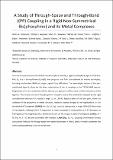A study of through-space and through-bond JPP coupling in a rigid nonsymmetrical bis(phosphine) and its metal complexes
Abstract
A series of representative late d-block metal complexes bearing a rigid bis(phosphine) ligand, iPr2P-Ace- PPh2 ( L , Ace = acenaphthene-5,6-diyl), was prepared and fully characterised by various techniques, including multinuclear NMR and single crystal X-ray diffraction. The heteroleptic nature of the peri- substituted ligand L allows for the direct observation of the JPP couplings in the 31P{1H} NMR spectra. Magnitudes of JPP are correlated with the identity and geometry of the metal, and the distortions of the ligand L . The forced overlap of the phosphine lone pairs due to the constraints imposed by the rigid acenaphthene skeleton in L results in large 4JPP of 180 Hz. Sequestration of the lone pairs, either via oxidation of the phosphine, or metal chelation, results in distinct changes in the magnitude of JPP. For tetrahedral d10 complexes ( [LMCl2] , M = Zn, Cd, Hg), the JPP is comparable or larger (193–309 Hz) to that in free ligand L , although the P···P separation in these complexes is increased by ca. 0.4 Å (compare to free ligand L ). The magnitude of JPP diminishes to 26–117 Hz in square planar d8 complexes ( [LMX2] , M = Ni, Pd, Pt, X = Cl, Br) and octahedral Mo0 complex [ LMo(CO)4] , 33 Hz). Coupling Deformation Density calculations indicate the through-space interaction dominates in free L , whilst in metal complexes the main coupling pathway is via the metal atom.
Citation
Chalmers , B A , Nejman , P L , Llewellyn , A V , Felaar , A M , Griffiths , B L , Portman , E I , Gordon , E-J L , Fan , K J H , Woollins , J D , Buehl , M , Malkina , O L , Cordes , D B , Slawin , A M Z & Kilian , P 2018 , ' A study of through-space and through-bond J PP coupling in a rigid nonsymmetrical bis(phosphine) and its metal complexes ' , Inorganic Chemistry , vol. 57 , no. 6 , pp. 3387-3398 . https://doi.org/10.1021/acs.inorgchem.8b00162
Publication
Inorganic Chemistry
Status
Peer reviewed
ISSN
0020-1669Type
Journal article
Description
This work was financially supported by the EPSRC (EP/M506631/1, EP/L505079/1) and COST action SM1302 SIPs. M.B. would like to thank EaStCHEM and the School of Chemistry for support; O. L. M. acknowledges financial support from the Grant Agency of the Ministry of Education of the Slovak Republic and Slovak Academy of Sciences VEGA (grant No. 2/0116/17) and from the Slovak Research and Development Agency (grant APVV-15-0726).Collections
Items in the St Andrews Research Repository are protected by copyright, with all rights reserved, unless otherwise indicated.

